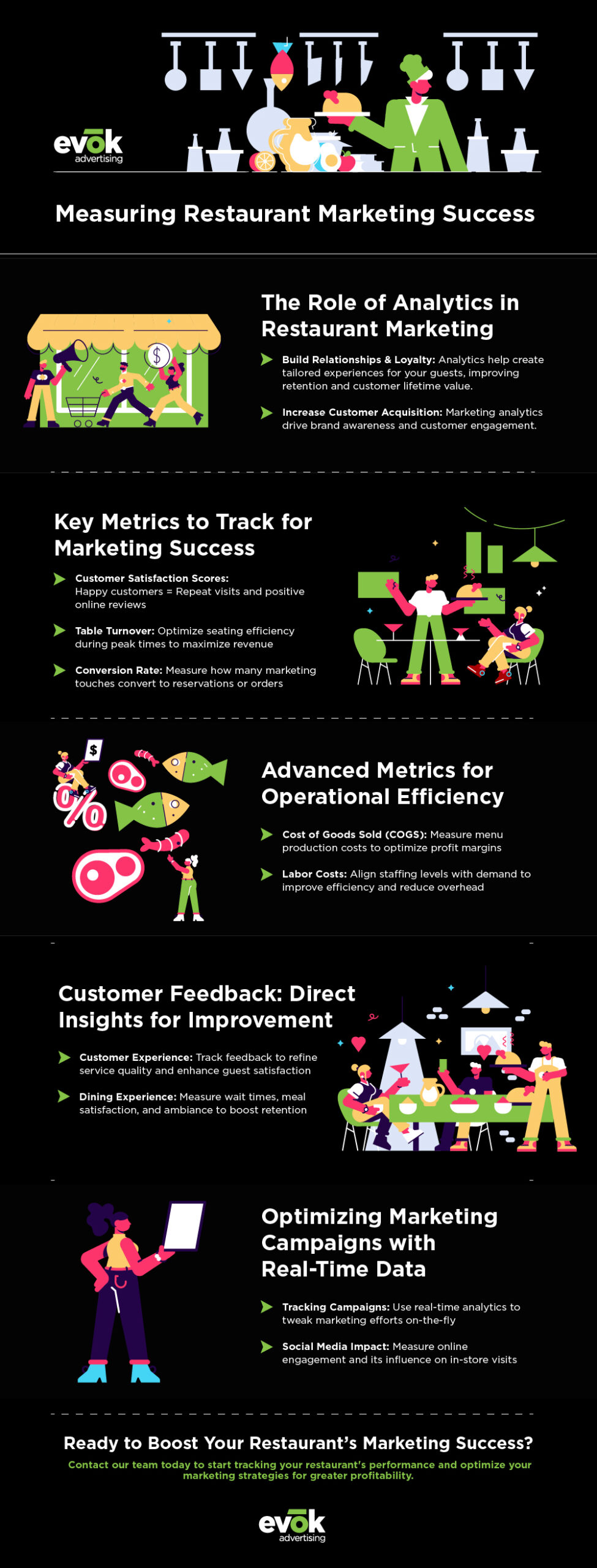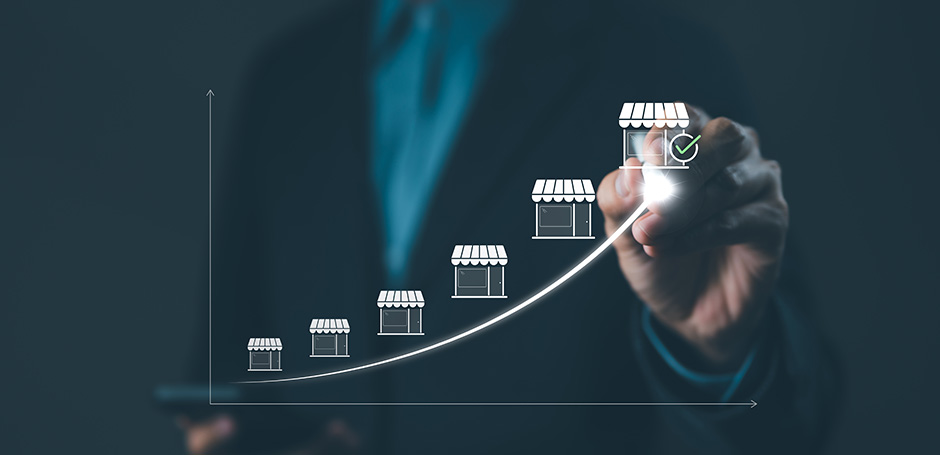
How to Measure Restaurant Marketing Success: A Restaurant Owner’s Guide to Analytics & KPIs
Running a successful restaurant isn’t just about serving great food — it’s about making smart decisions backed by data. Every menu item, every promotion, and every guest experience can be measured and improved with the right insights. That’s where restaurant analytics come in.
Instead of guessing which marketing campaigns are working or how to improve your dining experience, restaurant operators and Chief Marketing Officers can use data to guide decisions. From tracking customer preferences to optimizing table turnover, restaurant analytics help you take the guesswork out of running a successful business.
In this guide, we’ll explore how you can use restaurant analytics to measure and maximize your marketing success. Whether you’re looking to improve customer lifetime value or boost your table occupancy, our restaurant marketing agency is here to show you how the right KPIs and metrics can unlock the full potential of your restaurant.

Understanding Restaurant Analytics
Think of restaurant analytics as the key to unlocking your restaurant’s full potential. It’s not just about tracking data; it’s about using that data to uncover insights that guide smarter decisions. Whether it’s optimizing your marketing campaigns or enhancing the dining experience, the right analytics can be your most valuable tool.
At its core, restaurant analytics is about gathering and interpreting data to fine-tune business operations and marketing efforts. From tracking sales and customer satisfaction to measuring operational efficiency, the goal is to understand what’s working and what isn’t. It’s about more than numbers on a spreadsheet — it’s about identifying actionable insights that can drive growth.
For example, understanding your cost of goods sold (COGS) and break-even point reveals how effectively your resources are being used. Similarly, knowing conversion rates and customer feedback lets you evaluate the success of marketing campaigns and pinpoint areas for improvement.
Types of Analytics and Data
The world of restaurant analytics can be overwhelming, but focusing on the right metrics can make all the difference. Here’s a breakdown of the key data points every restaurant should be tracking:
Sales Data: This includes everything from daily sales totals to average revenue per customer. It helps you track the financial performance of your restaurant and determine whether your marketing strategies are paying off.
Customer Data: Gathering insights from customer feedback, preferences, and reviews gives you a deeper understanding of what keeps people coming back. This information is crucial for tailoring your marketing efforts and refining the dining experience.
Marketing Data: It’s important to know how well your marketing efforts are converting. Are your ads driving traffic? Is your social media strategy creating buzz? By analyzing conversion rates and tracking the effectiveness of different campaigns, you can ensure your marketing dollars are working as hard as possible.
Operational Data: Tracking table turnover, labor costs, and how often a table is occupied gives you a clear view of your restaurant’s efficiency. These metrics help you optimize staffing levels and improve the overall customer experience, leading to higher satisfaction and better profitability.
The Importance of Data Integration
When all of your restaurant’s data lives in separate silos, it’s harder to see the bigger picture. By integrating your analytics into a cohesive system, you can draw connections between different data points. For example, linking sales data with customer feedback lets you determine if a successful promotion is also boosting customer satisfaction. This holistic approach ensures that you’re making informed decisions that benefit every aspect of your business.
Key Performance Indicators (KPIs) for Restaurant Marketing

When it comes to measuring success, not all numbers are created equal. Key performance indicators (KPIs) are the metrics that matter most, offering a clear picture of how well your marketing strategies and operations are performing. Without KPIs, you’re left to make decisions based on gut feeling rather than data-backed insights.
Defining KPIs for Restaurants
KPIs are essential because they tie your marketing efforts and operational goals to tangible results. In the context of restaurant marketing, KPIs help you understand how well you’re attracting, retaining, and satisfying customers. By tracking the right KPIs, you can pinpoint areas of success and identify opportunities for growth.
Here are the most important KPIs every restaurant owner should monitor:
Conversion Rate: This is the percentage of potential customers who take action, whether that’s making a reservation after seeing an ad or clicking on a special promotion. Conversion rate is a critical indicator of how well your marketing campaigns are turning interest into actual business.
Table Turnover: How quickly your tables are filled and emptied has a direct impact on your revenue. Monitoring this KPI helps you determine if you’re maximizing your restaurant’s seating capacity and whether your marketing strategies are attracting enough customers during peak times.
Customer Satisfaction Scores: Happy customers are more likely to return and refer others. By measuring customer satisfaction through surveys, reviews, and feedback, you can gain valuable insights into how your dining experience, service quality, and atmosphere are being perceived. This KPI directly impacts customer loyalty and lifetime value.
Cost of Goods Sold (COGS): COGS reflects how much it costs you to produce the menu items that customers are ordering. Keeping this KPI in check is essential to ensuring your restaurant remains profitable while still offering quality food at competitive prices.
Customer Lifetime Value (CLV): CLV helps you understand the total revenue you can expect from a customer over the course of their relationship with your restaurant. This KPI highlights the importance of customer retention and the long-term value of building loyal relationships through targeted marketing strategies.
Why KPIs Matter
KPIs act as the guiding metrics that inform your restaurant’s decisions. They help you evaluate everything from marketing performance to operational efficiency. For example, if your table turnover rate is low, it might suggest that marketing campaigns aren’t reaching the right audience, or that your restaurant isn’t offering an experience that encourages quick seating. On the other hand, a high CLV tells you that your marketing and customer service strategies are effectively building long-term relationships.
Tracking KPIs regularly gives you the power to adjust strategies in real-time. Whether you need to tweak your menu offerings, optimize labor costs, or rework a marketing campaign, KPIs provide a clear pathway for making data-driven decisions that drive business growth.
Important Metrics to Track for Marketing Success

While KPIs give you a broad overview of performance, there are additional metrics that dive deeper into the specifics of your restaurant’s operations and customer interactions. By measuring these key metrics, you can identify how well your marketing efforts are resonating with guests and where there’s room for improvement.
The Role of Customer Feedback
Customer feedback is one of the most direct ways to gauge the success of your restaurant’s marketing campaigns. When you track reviews, surveys, and social media mentions, you’re collecting valuable data about how your restaurant is perceived.
Customer feedback isn’t just about complaints; it’s about understanding the aspects of your service and dining experience that customers love and want to see more of. Positive feedback can help reinforce your brand messaging, while constructive criticism gives you insight into areas that need improvement. Incorporating this feedback into your restaurant marketing strategies helps you refine your approach and better meet customer expectations.
Dining Experience as a Key Metric
The dining experience is at the heart of your restaurant’s reputation. Metrics that track the quality of this experience, such as wait times, meal satisfaction, and overall ambiance, directly affect customer retention and brand loyalty. A positive dining experience often leads to repeat visits, positive online reviews, and word-of-mouth recommendations.
In fact, the more positive your dining experience, the more likely you are to increase customer lifetime value. Satisfied customers are more willing to pay a premium for a great experience, and they’re more likely to recommend your restaurant to others.
Labor Costs and Operational Efficiency
Labor costs are one of the largest expenses for any restaurant. By analyzing labor efficiency — or how well you’re using your staff in relation to customer demand — you can ensure that you’re operating as efficiently as possible.
The key is aligning labor costs with peak and off-peak hours. During high-volume periods, you want to ensure that there are enough staff members to meet demand without overwhelming the kitchen or the service team. Conversely, during slower times, it’s important to optimize your staffing levels to avoid overstaffing and unnecessary costs.
Break Even Point: Understanding the Threshold
Your break-even point tells you exactly how much revenue your restaurant needs to generate in order to cover all operating costs. Once you surpass this threshold, your restaurant starts making a profit. Understanding this metric is essential for measuring the success of your marketing campaigns. If a particular promotion or marketing initiative pushes you beyond the break-even point, it’s a sign that your campaign is working effectively.
Analyzing Marketing Campaigns: Tools & Techniques

Understanding your restaurant’s data is one thing; knowing how to analyze it is another. That’s where the right tools come in. Using analytics software designed for restaurants, you can dig deeper into your campaigns and understand exactly how each effort is performing. Whether it’s tracking the ROI on a Facebook ad campaign or measuring how well a new menu item is performing, analytics tools give you the power to make informed decisions.
Marketing Analytics Tools for Restaurants
A wide range of tools exists to help restaurants track and analyze their marketing campaigns. These tools make it easier to collect data from different sources, such as social media platforms, email marketing systems, and point-of-sale (POS) systems, all in one place. Some popular tools include:
Google Analytics: Track website traffic, measure user behavior, and understand how customers are engaging with your restaurant online.
Social Media Analytics Tools: Platforms like Facebook, Instagram, and Twitter offer built-in analytics tools to measure engagement, reach, and conversions from social media posts and ads.
Customer Relationship Management (CRM) Software: CRMs allow you to track customer interactions, segment your audience, and personalize your marketing messages based on customer data.
POS Analytics: Many modern POS systems provide detailed insights into your sales, order history, and customer preferences, helping you track revenue and optimize marketing efforts.
Measuring ROI in Restaurant Marketing
Knowing how to calculate return on investment (ROI) is essential for assessing the effectiveness of your marketing campaigns. ROI helps you understand whether the money you’re spending on advertising and promotions is actually bringing in new business. The formula for calculating ROI is:
ROI = (Revenue from Campaign – Cost of Campaign) / Cost of Campaign
For example, if you spent $1,000 on an ad campaign and earned $3,000 in sales, your ROI would be 2, meaning you made $2 for every dollar spent. Tracking ROI across different campaigns helps you identify which marketing channels are performing well and which ones need adjustment. If a particular campaign isn’t yielding a strong ROI, it might be time to tweak the messaging, target audience, or the platform you’re using.
Using Customer Data to Improve Campaigns
The beauty of restaurant analytics is that it’s not just about measuring performance — it’s about using the insights to improve. Once you’ve analyzed a campaign’s performance, it’s time to adjust. For instance, if you notice that a social media campaign is driving traffic but not generating conversions, you might consider refining your call to action or offering a time-sensitive discount to encourage immediate action.
How to Use Analytics to Improve Restaurant Marketing Strategies

Data without action is just numbers. To truly benefit from restaurant analytics, it’s essential to apply the insights you gather and fine-tune your marketing strategies. Whether you’re focused on driving new customers, increasing repeat visits, or optimizing your service, analytics can help you adjust your approach in real time. Here’s how to turn your data into smarter marketing decisions:
Refine Campaigns Based on Data
Once you’ve tracked your KPIs and metrics, it’s time to put them to use. If your conversion rates are low on a certain campaign, consider tweaking the messaging or offer to make it more compelling. Likewise, if customer satisfaction scores are dipping, it may indicate a need for improvement in customer service or the dining experience. Use the data you’ve collected to make adjustments to your campaigns, making them more aligned with customer expectations and behaviors.
Personalize Marketing Efforts
One of the most powerful ways to use analytics is to create personalized marketing campaigns that resonate with your customers. By tracking customer preferences and behavior, such as favorite menu items, dining frequency, and engagement with past promotions, you can create targeted campaigns that speak directly to each segment of your audience.
For example, if you notice that a certain group of customers frequently orders a specific dish, send them a personalized email with a special discount on that item. Personalization can boost customer loyalty and increase conversion rates by making your marketing feel more relevant and timely.
Customer Retention vs. Acquisition
Restaurant analytics can also help you strike the right balance between customer retention and acquisition. Both are essential, but each requires different marketing strategies. Retaining existing customers is typically more cost-effective than acquiring new ones. Use analytics to track customer lifetime value (CLV) and focus marketing efforts on building long-term relationships with loyal guests. Offering loyalty programs, personalized promotions, or exclusive events can help keep your regulars coming back.
On the flip side, if you’re looking to bring in new business, analytics can guide you in identifying underperforming areas and new target audiences. Adjust your marketing campaigns to reach fresh prospects, whether through geo-targeting, influencer partnerships, or local collaborations. Knowing where to allocate resources — and when — can significantly improve your customer acquisition efforts.
Test, Adjust, Repeat
One of the key benefits of using restaurant analytics is the ability to test and experiment. Don’t be afraid to try new approaches, whether it’s testing a new ad creative, offering a new menu item, or experimenting with the timing of your promotions. Use A/B testing to compare different variations of a campaign to see which one performs better. The goal is to learn from each test, adjust your strategy, and continue improving your marketing efforts over time.
Using Restaurant Analytics to Optimize Profit Margins
Profit margins are the backbone of any successful restaurant. Understanding how to leverage analytics to keep these margins healthy is essential for long-term sustainability. Restaurant analytics help you pinpoint areas where you can reduce costs, improve efficiency, and ultimately boost your bottom line.
Cost Management and Profitability
By tracking operational metrics like cost of goods sold (COGS) and labor costs, you can identify where money is being spent inefficiently. COGS is particularly important — it measures how much it costs to produce each dish on your menu, and keeping this figure low without compromising quality is key to maintaining healthy margins. Regularly reviewing your COGS data lets you see where you can reduce food waste, negotiate better prices with suppliers, or adjust your menu pricing.
Similarly, labor costs can eat into your profit margins if not carefully managed. By using restaurant analytics to track peak times and staffing levels, you can optimize your team’s schedule to match customer demand. This ensures that you’re not overstaffing during slower periods and understaffing during busy times, which can affect both your bottom line and customer experience.
Menu Optimization
Another way to optimize profit margins is by leveraging analytics to refine your menu offerings. Analyzing sales data and customer preferences helps you identify which items are driving revenue and which are underperforming. By removing low-profit items and promoting high-margin dishes, you can increase the profitability of each sale. Additionally, pricing analysis can help ensure that your menu prices align with your target profit margins while remaining competitive in your market.
Labor Costs and Operational Efficiency
Optimizing labor costs doesn’t just help your profit margins; it also impacts your overall efficiency and customer experience. The goal is to ensure you’re staffed appropriately based on the time of day and expected customer traffic. Restaurant analytics tools can provide data on customer flow, peak hours, and employee performance, which makes it easier to create efficient work schedules.
Understanding how many tables are occupied and how quickly they turn over during different shifts will also help you fine-tune labor allocation. If you’re able to streamline your operations and keep overhead costs in check, you can improve your profit margins significantly while still maintaining excellent service quality.
Fine-Tuning Your Marketing Strategies with Real-Time Data

One of the major advantages of restaurant analytics is the ability to monitor and adjust marketing strategies in real-time. By continually tracking the performance of your campaigns and operational metrics, you can make on-the-fly changes that have an immediate impact on your restaurant’s success. Whether it’s tweaking a social media post or adjusting a promotion that’s not resonating with customers, real-time data allows you to be agile and responsive.
Adjusting Marketing Efforts Based on Immediate Feedback
When you monitor customer feedback and customer satisfaction scores in real-time, you gain valuable insights into how your marketing campaigns are landing with your target audience. For example, if a new promotion isn’t driving as much engagement as expected, you can adjust the messaging or increase the promotion’s visibility through paid ads or social media. Quick action like this prevents missed opportunities and ensures your campaigns stay relevant to your audience.
Real-time data also enables you to react to seasonal shifts, changes in consumer behavior, or unexpected events like local festivals or weather changes that impact restaurant traffic. By adjusting your marketing efforts accordingly, you can capitalize on these opportunities without missing a beat.
Improving Campaign Timing with Analytics
Restaurant analytics can also help you determine the best times to run specific campaigns. For example, if your data shows that your customers tend to be most active on social media around lunchtime, you can schedule your ads or promotions during those hours to increase visibility and engagement. Similarly, understanding the peak hours of your restaurant’s traffic can help you time discounts or special offers to coincide with high-demand periods, driving more business during these critical times.
The Bigger Picture: Building a Data-Driven Culture in Your Restaurant
Successful restaurant marketing isn’t just about tracking metrics — it’s about fostering a data-driven culture across all areas of your business. When your team is aligned around the importance of data and analytics, you can make more informed decisions that improve everything from customer service to operational efficiency. Creating a culture that embraces data allows you to continuously improve your restaurant’s performance, making it easier to achieve long-term success.
Empowering Your Team with Data
To make the most of your restaurant analytics, it’s important that everyone in your organization understands how to use and apply the data. This means educating your team on the key metrics that matter, such as table turnover, cost of goods sold, and labor costs, and showing them how these metrics impact daily operations and marketing efforts.
For instance, your servers can use customer data to personalize their service, whether by remembering regular customers’ preferences or offering recommendations based on past orders. Kitchen staff can optimize efficiency by understanding which menu items are most popular and ensuring they’re always in stock. By involving your entire team in the data-driven approach, you turn analytics into a tool for improving the customer experience at every level of the business.
Creating Continuous Improvement Loops
Data should never be seen as a one-time tool for decision-making; instead, it should be part of a continuous improvement loop. When you regularly review your KPIs and operational metrics, you can identify areas where your restaurant can grow and evolve. For example, if labor costs are rising during certain shifts, you can adjust scheduling to better match demand. Or if a particular promotion isn’t yielding the expected results, you can tweak it for future iterations.
Turning Analytics Into Action

Restaurant analytics are more than just a set of numbers — they’re the foundation for smart, data-driven decisions that fuel your restaurant’s success. From measuring the effectiveness of your marketing campaigns to optimizing your operational efficiency, every piece of data plays a role in building a stronger, more profitable business.
By regularly tracking and analyzing key performance indicators (KPIs) such as conversion rates, customer satisfaction scores, cost of goods sold, and labor costs, you gain the insights needed to refine your marketing strategies, improve customer service, and boost profit margins. The key is not only collecting data but using it to drive meaningful change within your restaurant.
Ready to take your restaurant marketing to the next level? Embrace the power of restaurant analytics, track your performance, and make the data work for you. Reach out to our restaurant marketing agency team today.